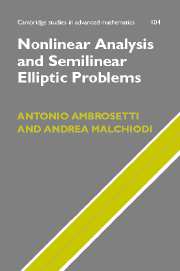Book contents
- Frontmatter
- Contents
- Preface
- 1 Preliminaries
- Part I Topological methods
- Part II Variational methods, I
- Part III Variational methods, II
- 9 Lusternik–Schnirelman theory
- 10 Critical points of even functionals on symmetric manifolds
- 11 Further results on elliptic Dirichlet problems
- 12 Morse theory
- Part IV Appendices
- References
- Index
10 - Critical points of even functionals on symmetric manifolds
from Part III - Variational methods, II
Published online by Cambridge University Press: 19 May 2010
- Frontmatter
- Contents
- Preface
- 1 Preliminaries
- Part I Topological methods
- Part II Variational methods, I
- Part III Variational methods, II
- 9 Lusternik–Schnirelman theory
- 10 Critical points of even functionals on symmetric manifolds
- 11 Further results on elliptic Dirichlet problems
- 12 Morse theory
- Part IV Appendices
- References
- Index
Summary
In this chapter we will investigate the case that J is an even functional and M is a symmetric set. The abstract results will apply to a class of nonlinear elliptic problems with odd nonlinearities.
The Krasnoselski genus
Theorem 9.10 does not give any new result when M = S is the unit sphere in a infinite dimensional Hilbert space E because cat(S) = 1 in such a case. On the other hand, if A is a linear compact positive operator, the quadratic functional J(u) = (Au | u) has infinitely many critical points zk, corresponding to the solutions of the linear eigenvalue problem Au = λu. We will show that, more in general, any even functional on an infinite dimensional Hilbert sphere, satisfying the (PS) condition on S and bounded from below on S, possesses infinitely many critical points on S. In order to obtain such a result one could consider the projective space ℙ∞ = S/ℤ2 (see Example 9.4(iv)) and use the L-S theory. On the contrary, we will use a topological tool, the genus, which will substitute the category in the case of ℤ2 symmetry. The genus was introduced by M. A. Krasnoselski [110]; we will follow [149].
Let A denote the class of all closed subsets A of E \{0} which are symmetric, namely u ∈ A =⇒ −u ∈ A.
Definition 10.1Let A ∈ A. The genus λ (A) of A is defined as the least integer n such that there exists ψ ∈ C(E, ℝn) such that ψ is odd and ψ(x) ≠ 0 for all x ∈ A.
- Type
- Chapter
- Information
- Nonlinear Analysis and Semilinear Elliptic Problems , pp. 157 - 176Publisher: Cambridge University PressPrint publication year: 2007

